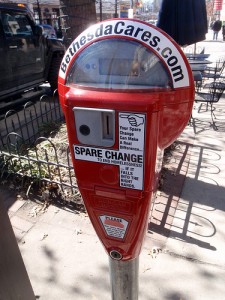Advancements in Panhandling: Don't Forget to Feed the Meter
 Photo: Daquella manera
Photo: Daquella maneraBack in 2006, I wrote a Newsweek article about the problems that warm-weather cities like Orlando and Las Vegas were having with their homeless populations, and the rather creative methods they were using to control them — namely banning public feedings and consigning all panhandling to 3-by-15-foot “panhandling zones” painted on sidewalks.
Turns out the solutions have only gotten more creative in the last few years. The newest innovation are “homeless meters,” repurposed parking meters — painted a different color and set back from the street — that people can deposit coins into rather than give spare change to panhandlers. Cities then donate the collected money to nonprofit groups, which in turn use the funds to buy things like bus tickets. Advocates say this cuts down on the abuse of funds, and ensures that donations are put to the best use.
Homeless meters have cropped up in a number of cities over the last few years including Indianapolis, San Francisco, Atlanta, Cleveland, Baltimore, Virginia Beach, Denver and Las Vegas. Last fall, Orlando’s city council voted to install 15 of them in its downtown district. It’s also reduced the city’s number of panhandling zones from 36 to 27.
This week, Lawrence, Kansas, became the latest city to vote to install homeless meters. Collecting data on the effect that homeless meters have on donations is probably next to impossible, as we’ll never know how much the homeless collected by panhandling. But it does seem like a good solution in that it addresses the fear that many potential donors have that their spare change gets spent on things that got the homeless person into trouble to begin with, namely alcohol or drugs. Still, there’s something coldly detached about homeless meters, and of addressing homelessness the same way you pay for a parking spot: by feeding the meter.
What do you readers think? Is this a good alternative to panhandling?
[HT: Brad Wilson]

Comments